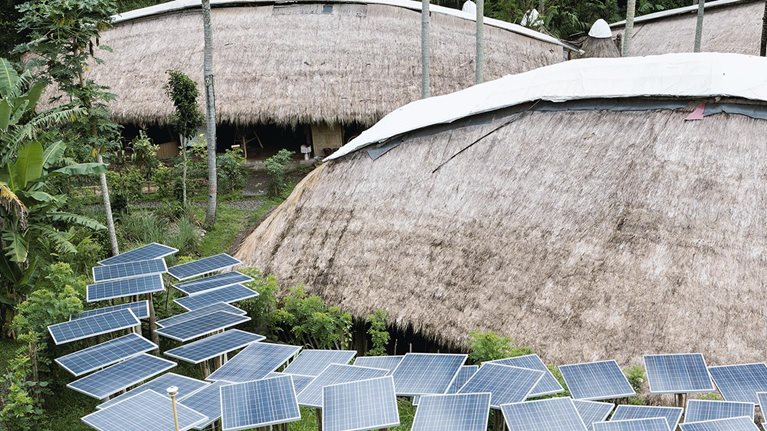At a glance:
- Extreme weather events, like the record-breaking heat waves in Phoenix, Arizona, and the extreme precipitation in the Sindh province of Pakistan, are becoming increasingly common in communities around the world. While humanity has long adapted to various climatic conditions, climate change is happening faster today than before and is giving rise to conditions that could threaten the habitability of some of the planet’s most populated areas.
- Given the magnitude and systemic nature of the impacts of climate change, the public sector has a leading role in propelling adaptation. Sixty-five percent of the world’s countries have already developed at least an initial national adaptation plan, covering 61 percent of the world economy and 65 percent of the world population, as of July 2023. Of the remaining global population, almost a third lives in Nigeria, Pakistan, and the United States, which are currently developing their first national adaptation plans, and in India, where climate adaptation is primarily realized through a system of state plans.
- Still, much more remains to be done. Even though the implementation rate of these plans is increasing, many lack critical details and are not keeping up with the rapid evolution of climate impacts. The climate future is uncertain, and the impact of warming will not be linear and will be different from place to place. This requires public policy planners to be flexible, regularly explore a range of climate outcomes, and determine the level of climate risk they want to prepare for.
- We outline five potential actions for governments and government agencies to consider as they start or continue their adaptation journeys. They are the following: set adaptation goals based on defined future climatic conditions and desired preparedness, integrate adaptation into government decision making, approach adaptation with a multilevel focus, systematically engage private sector actors and investors to mobilize funding and promote innovation, and establish and institute centralized principles for monitoring and evaluation throughout the adaptation life cycle.
It’s 4 p.m. on July 30, 2023. Pima Park in the metropolitan area of Phoenix, Arizona, is eerily empty. Normally, on a beautiful summer Sunday, the park is bustling with children. But the local temperature has reached a high of more than 110°F (43°C) for a record 31 days in a row. A year earlier, a similarly extreme heat wave was making headlines across the United States. In July 2022, 350 new daily-high-temperature records were set across the country, and over 100 million people were put on heat alert. In August 2022, in the densely populated province of Sindh, Pakistan, 15 days of extreme precipitation, reaching more than five times the 30-year average, unleashed exceptional flooding, submerging one-third of the country. The flood, widely described as the worst in Pakistan’s recent memory, ultimately affected 33 million people and destroyed more than 1.7 million homes. The total toll in human lives of such events is large and increasing. A recent study in the Economist estimated the excess mortality in South Asia due to extreme heat at around 110,000 people annually.
Humanity has long adapted to various climatic conditions through migration, behavioral changes, and technological solutions. But today’s climate change is of a different nature: it is the direct result of human activity, is happening faster than before, and is giving rise to conditions that could threaten the livability of some of the planet’s most populated areas. Increasingly frequent and intense climate-related events highlight the need for a more deliberate and coordinated approach to adaptation than in the past. To be clear, the scale and speed of the evolution of the problem are highly variable across geographies and the effects over the next decade will be more muted in certain places than in others. While this buys time for action and makes climate change more manageable, it does not alter the necessity of embarking on a journey that might in time entail major changes across countless systems and processes.
This article focuses on the design and implementation of adaptation plans in the public sector. In the first part, we take stock of the current state of national adaptation plans—the unified body of strategies to adapt to climate change defined and published by national governments. While the implementation rate of these plans is increasing, many of them still lack critical details (for example, many lack a timeline for implementation or a prioritization of solutions or costs) and are not following the rapid evolution of climate impacts.
In the second part, we outline a potential response, including five actions governments and government agencies can consider:
- Examine and set adaptation goals based on defined future climatic conditions (1.5°C, 2°C, 2.5°C, and 3°C, and over various time horizons) and with a view on the speed at which these conditions might occur and on the desired and/or possible level of preparedness, while maintaining flexibility to navigate uncertainties.
- Broadly integrate adaptation into government decision making; evaluate costs and trade-offs, while maximizing cobenefits.
- Approach adaptation with a multilevel focus; ground solutions in the local context and coordinate at the national and global levels.
- Systematically engage private sector actors and investors to mobilize funding and drive innovation.
- Establish and institute centralized principles for monitoring and evaluation throughout the adaptation life cycle.
While we focus on the public sector, we recognize that adaptation success will draw on a broader set of requirements, which we outline in a separate article, “Ten key requirements for a systemic approach to climate adaptation.” As we analyze the role of the public sector, we highlight its unique capacity to establish standards, foster knowledge sharing, and propel coordinated efforts that can pave the way for a more resilient future.
Taking stock of public sector adaptation planning today
Visible progress has been made in developing national adaptation plans over the past five years. As of June 2023, 65 percent of countries (128 out of 198) had developed such plans, covering 61 percent of the world economy and 65 percent of the world population and marking a clear first step in the global effort to adapt to climate change (see sidebar “Methodology”). Even among countries without a formal national plan, we observe some progress toward adaptation planning. Almost a third of the global population living in a country without national adaptation plan coverage is in Nigeria, Pakistan, and the United States, which are developing national plans, and in India, where climate adaptation is primarily realized through a system of state plans (see sidebars, “Adaptation planning in the United States” and “Adaptation planning in India.”).
The progress of national adaptation plans has been primarily propelled either by the United Nations Framework Convention on Climate Change (UNFCCC), which provides funding and technical assistance to vulnerable nations, or by the European Commission, which requires plans from EU member nations. Together, UNFCCC and the European Commission have facilitated nearly 60 percent of existing plans. The remaining 40 percent have been published independently (Exhibit 1).
We conducted an analysis on a sample of national adaptation plans. We selected 50 countries to represent the world’s diverse approaches to adaptation. We made sure to include most of the world population, as well as regions where exposure to climate hazards is greatest (Exhibit 2).
In our sample, 70 percent of countries (35 out of 50) published a national adaptation plan. Most plans identify relevant climate hazards, propose solutions, and consider multiple warming scenarios, but meaningful challenges remain. In addition, most of them highlight climate hazards that have been historically experienced or are expected based on location (for example, most countries with a coastline including sea level rise as a hazard). What’s more, most plans consider many different climate scenarios in their projections and propose a wide range of solution levers. They also provide an implementation framework for their adaptation solutions.
Our analysis reveals three significant challenges:
1. While more adaptation plans have been developed in recent years, an increased pace of renewal and refinement is required. The world’s understanding of climate impacts is constantly evolving. Additionally, these impacts are dependent on changes in global emissions over time. Adaptation plans are therefore best developed through iterative refinement. However, 25 percent of published national adaptation plans (32 out of 128) are already more than seven years old, and many lack formal commitments for updates.
2. Many plans require key additional details to be actionable, such as a timeline for implementation, prioritization of solutions, and costs. In our sample, 40 percent of plans (14 out of 35) do not provide any timeline for implementation. Only 51 percent (18 out of 35) map these actions to hazards or prioritize risks (for example, erecting floodwalls and restoring natural features like sand dunes as adaptation measures to protect against sea level rise). Thirty-seven percent of plans (13 out of 35) suggest a list of potential actions without providing a prioritization methodology. Finally, only 31 percent of plans (11 out of 35) estimate adaptation costs, and those that do take varying approaches.
3. Many plans have yet to put in place a system to evaluate interventions and monitor their execution. Our sample analysis shows that while 80 percent (28 out of 35) of national adaptation plans mentioned the need for monitoring and evaluating, only a third have included a formal framework to do so. These mechanisms, however, are critical to monitoring and evaluating execution, redefining goals and interventions in light of new information, and reinforcing accountability.
Five potential actions for governments and government agencies to consider in the shorter term
We outline five key actions that can help anchor and enable the adaptation journey. This list is not meant to be exhaustive but to offer a tangible path forward in most cases.
Action 1: Set goals based on a range of future climatic conditions over various time horizons
The climate future is clear in its direction (in the absence of a major correction) and uncertain in its timing, details, and—most importantly—feedback loops within and among various physical and socioeconomic systems. We are operating outside of temperature ranges we have seen historically. The global mean surface temperature has increased by about 1.1°C above preindustrial levels, and this change is happening orders of magnitude faster than at any other time in at least the last 2,000 years, according to the Sixth Assessment Report of the Intergovernmental Panel on Climate Change.
This singular situation carries three areas of uncertainty:
First, significant additional warming is expected, but its full extent is undefined. Even the most optimistic scenarios reach 1.5°C of warming above preindustrial levels in the early 2030s. That would be the minimum level against which to protect societies from projected climate change impacts. Beyond this, future increases in temperature (2°C, 2.5°C, 3°C) are more uncertain.
Second, the impacts of warming are nonlinear. Linear increases in global average temperature (from 1.5°C to 2°C to 2.5°C) are associated with nonlinear increases in the frequency and severity of extreme weather events. At today’s warming of about 1.1°C, for instance, less than 1 percent of the total projected global population (about 0.1 billion) is likely to be exposed to severe heat stress. However, at 2°C of warming, this proportion increases to one-sixth (about 1.4 billion people). And this is before factoring in the interaction between climate and biological systems, which needs to be better understood and integrated.
Third, there is a lack of clarity on how systems that are already operating at capacity will operate under the impacts of further warming. In some geographies, for instance, already underresourced and underdeveloped forest management services are now also struggling to cope with more frequent and intense wildfires, while water systems—already under strain due to overpopulation, obsolescence, and misaligned incentives—are seeing the additional impact of changing rainfall patterns and increased droughts and floods.
In light of this uncertainty, three steps can help governments and government agencies better prepare for future climatic conditions.
1. Explore a range of potential climatic outcomes to effectively navigate uncertainty, while establishing a central planning scenario that is continually tested and improved to guide further planning. As they analyze potential adaptation interventions, governments could benefit from considering different climactic scenarios (1.5°C, 2°C, 2.5°C, 3°C), as well as various time horizons, and the desired and/or possible level of preparedness. Argentina’s National Climate Change Office, for example, has created an online tool that generates physical risk maps for both moderate- and high-ongoing-emission scenarios (1.5–2.0°C and 2.0–3.0°C in 2050, respectively). These maps forecast temperature ranges for 2030, 2050, and 2100, as well as their associated physical hazards, such as precipitation or extreme heat. In addition, they overlay social vulnerabilities (for example, exposure to diseases, aging populations), empowering actors to take systemic-adaptation-planning decisions.
It is also critical for governments and government agencies to select a central scenario to anchor adaptation thinking, planning, and implementation, as the magnitude of impacts can vary under different scenarios. To continually ensure robustness, this central scenario should be regularly tested and improved based on new data and modeling. Take, for instance, the decision that many South American countries face in determining the temperature to which they might need to adapt (Exhibit 3). An increase in warming of 1.5°C could result in up to about two more months with local temperatures above 35°C. At 3°C, this risk rises to about four more months.
Of course, changes in global temperature may also cause higher-order impacts on economic development, food and energy security, infrastructure, and, crucially, health. These impacts make planning even more important.
2. Determine the desired level of adaptation, which risks (or extreme weather events) to protect against, and the degree of protection desired. This can entail preparing for events that are relatively frequent (once every ten years) or highly infrequent (once every 10,000 years) today but may increase in frequency in the future. One example of a government’s choosing a level of adaptation can be seen with the Maeslant storm surge barrier in Rotterdam, Netherlands, which is the largest mobile barrier in the world and was constructed to withstand a range of storm intensities. The barrier is designed for up to a once-in-10,000-years storm and storm surges from three to five meters in height. It is part of the Netherlands’ investment to adapt to sea level rise, with a total cost exceeding $500 million. Other Dutch flood protection infrastructure assets with similar protection standards had even higher construction costs, such as the $2.4 billion Eastern Scheldt Barrier. However, the significant cost of the infrastructure work is weighed against the fact that such an extreme event could cause massive disruptions across the entire country and that constructed assets have a long expected lifetime. Other governments could benefit from performing similar analyses before investing in adaptation infrastructure.
3. Design adaptation plans to be dynamic and flexible under a range of potential climate futures. Flexibility within adaptation solutions is essential to address uncertainty. Solutions could contain multiple options to allow enough flexibility to fit whichever scenario unfolds. While the initial cost of these types of solutions may be higher, they can result in significant savings.
Action 2: Broadly integrate adaptation into government decision making
Adaptation planning intersects with many public priorities such as economic development, housing, public health, and climate change mitigation. By using these intersections, governments, multilateral institutions, and philanthropies can magnify adaptation impact and seek to generate positive outcomes for broader groups of stakeholders (as well as avoid unintended consequences). There are three steps in particular that governments can take to optimize adaptation decision making.
1. Consider prioritizing opportunities with cobenefits extending beyond adaptation, where it makes sense to do so. A fertile area for such opportunities is the intersection of adaptation and mitigation. Each opportunity serves a distinct role, yet each can often offer mutual benefits. A hectare of mangroves, for example, can store 1,000 tons of carbon on average. Mangroves also prevent soil erosion and protect coastlines and nearby infrastructure from damage caused by storm surges or other extreme events (Exhibit 5).
2. Design adaptation planning in a cross-government manner. Public institutions are best served by avoiding silos and promoting coordination. For every major investment or infrastructure project, assessments should ideally be made under multiple climate scenarios. They can consider, for example, how adaptation to extreme heat risk intersects with public health impacts, such as exhaustion, heatstroke, and dehydration. As institutions look at the intricate relationship between adaptation and health, they can come up with more comprehensive strategies.
Furthermore, climate change disproportionately affects more vulnerable communities, and adaptation strategies can not only protect lives but also enhance livelihoods. The World Bank’s Colombia Resilient and Inclusive Housing Project, for example, focuses on improving housing for low-income families in high-risk areas. Using detailed hazard and climate risk maps, the project targets municipalities at risk of landslides and floods.
3. Seek to avoid maladaptation by evaluating the potential risks and unintended consequences of adaptation actions during solutions design. Adaptation solutions can result in “maladaptation,” which occurs when adaptation actions lead to increased risks, such as higher greenhouse gas emissions, heightened vulnerability to climate change, inequitable outcomes, or diminished welfare. Policies that reduce incentives to adapt or that lock in only one adaptation pathway, restricting future actions, are also examples of maladaptation. Such negative effects can be seen in the case of the seawalls on Vanua Levu, Fiji, which were designed as a shield against rising sea levels but inadvertently increased potential hazard exposure by hindering stormwater drainage. The structures also unintentionally redistributed risks to other coastal communities through changes in sediment deposits and resulted in unintended environmental consequences, threatening the health of the marine ecosystems. Maladaptation can also occur in the context of insurance, which provides an important mechanism for transferring and distributing risks but can also lead to suboptimal decisions and/or moral hazards if it is not carefully managed. Agricultural climate insurance, for example, may lead farmers to deprioritize adaptation levers like intercropping and soil moisture maintenance techniques and increasingly rely on cash crops over more resilient subsistence crops, because they offer higher-insurance-compensation potential. Insurance can also give undesirable incentives to people who deliberately choose to inhabit high-risk areas, because they do not assume the full costs of climate hazards.
A few countries, such as Canada, Finland, and the United Kingdom, have started acknowledging and explicitly addressing maladaptation in their national adaptation plans.
Action 3: Approach adaptation with a multilevel focus at the local, national, and global levels
Effective adaptation requires involvement from public entities at the local, national, and global levels, and the optimal setting for decision making can vary. Many cities, for instance, have led local actions to build resilient communities, notably with the guidance of the C40 and Resilient Cities networks.
This potential action requires public sector participation on three levels:
1. Local parties engaging in targeted action within their communities. Local actors, including community leaders and inhabitants, play a vital role in understanding the implications of climate risks and developing effective adaptation interventions. The people on the ground often know firsthand how hazards manifest in their context. Drawing from historical experience, familiarity with local topographies, and close communal and cultural ties, local leaders are well positioned to anticipate impacts from risk (for example, flood-prone zones in their locality that are particularly vulnerable during the monsoon) and identify interventions. In Maharashtra, India, for instance, the local community organization Swayam Shikshan Prayog established a climate-resilient farming model for local women who had suffered from malnutrition. It identified the needs of the community and came up with interventions, such as moving from cash crops to certain food crops and focusing on specific women’s groups. These interventions may strengthen local food supply, thereby supporting climate adaptation and local communities.
The involvement of local community members can foster trust and active participation, especially for traditionally marginalized groups, and help national and global actors better understand risks and potential solutions. Early participation of local inhabitants can help shape acceptable adaptation solutions from the beginning. Adaptation measures can be disruptive, and not engaging local actors can increase maladaptation risk. In Vietnam, for example, forest management policies designed to manage flood risks are reported to have limited local mountain people’s access to land and resources as an unintended impact. In this context, local actors can play a pivotal role in building trust, reinforcing mutual understanding, and improving the effectiveness of adaptation.
In some cases, national governments have set the groundwork and provided local actors the flexibility to determine their adaptation pathway. In other cases, national governments have established a mandate for local governments to create and implement their own adaptation plans. This is, for example, the case in the Philippines, where about 80 percent of local government units have submitted adaptation plans. A third approach, particularly effective for smaller countries, has been to engage local stakeholders in the development of national plans, while maintaining decision making at the national level.
2. National actors coordinating efforts, facilitating knowledge sharing, and managing funding allocation. Central governments can play a key role in adaptation by setting targets, creating a foundational knowledge base, and coordinating action to align with national priorities. They can also put forward and implement a vision for climate adaptation, including determining central scenarios to adapt to, defining common goals, and identifying necessary interventions to achieve desired outcomes. In addition, when functioning and coordinating effectively, national actors are well positioned to build and disseminate critical knowledge, data, and best practices. At the same time, they can empower local actors with the necessary resources to make well-informed decisions. South Africa’s Let’s Respond Toolkit, for example, provides an overview on integrating climate change into municipal planning.
3. Global actors supporting broader systemic issues, such as setting global standards, sharing best practices, and helping funnel financing to vulnerable countries. Global coordination is often necessary to evaluate transnational impacts of adaptation solutions, reallocate support to the most vulnerable countries, and bring down the unit cost of adaptation. Global actors like the European Union and the United Nations can be well equipped to share best practices and set standards; they have been especially instrumental in encouraging and supporting countries to establish national adaptation plans. Technical support and expertise provided by the United Nations was a determining factor for over 60 developing countries creating their first adaptation plans. When operating effectively, coalitions of governments are well positioned to assess broader implications of adaptation measures and mediate outcomes, preventing initiatives of one nation from creating maladaptive outcomes in another (for example, building dams across transnational water sources).
For their part, international foundations and nongovernmental organizations (NGOs) can enable the development at scale of adaptation technologies and solutions by pooling global resources and supporting development of advanced, localized expertise. Recent adaptation grants from the Bill & Melinda Gates Foundation, for example, have supported the development of a weather intelligence platform to provide farmers with climate-smart agricultural information, research into developing strains of native grasses that enhance soil health, and funding for African scientists’ and researchers’ engagement efforts with national governments to shape adaptation policy. In India, Tata Trusts has helped fund a nonprofit organization’s efforts to restore bodies of water that have been degraded and depleted by long periods of drought in Maharashtra.
Finally, global actors such as international development banks and regional investment funds can help reallocate resources to reinforce the adaptation potential of the countries most susceptible to the impacts of climate change. A notable example of this kind of cooperation is the Green Climate Fund’s first-loss investment of $253 million into the Africa Finance Corporation’s Infrastructure Climate Resilient Fund (ICRF). Through IRCF, the Africa Finance Corporation finances climate-resilient greenfield and brownfield infrastructure across the region to future-proof existing infrastructure while enabling new infrastructure to be planned with climate change in mind.
Action 4: Systematically engage private sector actors and investors to mobilize funding and drive innovation
Governments and government agencies face challenges that private sector actors can help, at least partially, address. In many contexts, for instance, public funding for adaptation falls short. This is most apparent in developing countries, where resources are spread thinly across competing priorities. In 2022, the United Nations estimated that the adaptation finance gap alone in developing countries is five to ten times larger than today’s total flow of international funds and continues to widen. In our sample, the 11 countries with implementation cost estimates had a combined amount of $433 billion. For perspective, the United Nations expects adaptation to require investments of up to $300 billion a year globally by 2030.
To catalyze engagement from private sector actors, governments could gain from first understanding the private sector’s specific challenges in relation to climate risks and tailoring their approach accordingly. Private sector actors often do not have clarity on climate risks and their associated costs, making it difficult for them to manage risks efficiently and assess potential ROI. Governments could address these challenges by taking three steps.
1. Provide private sector actors and investors with clear and transparent regulations, along with guidance and adequate notice. Private sector actors often lack easy access to adaptation needs and opportunities where their involvement would be beneficial. For example, they are often unaware what funding is needed as only 29 percent of national adaptation plans in our analysis (ten out of 35) include cost estimates for adaptation interventions. Relevant government agencies can help provide resources and expertise to ensure adaptation interventions are costed appropriately.
Government bodies can also influence private sector actors to reallocate funding toward climate adaptation initiatives with regulations that seek to make climate risks more evident. Governments can adjust securities law and fiduciary standards to explicitly include climate-related risks. The European Union, for example, requires financial-market participants to disclose sustainability risks. In Canada and the United States, securities regulators are considering rules to require publicly traded companies to disclose how their businesses are managing climate-related risks. Finally, governments can also enact new standards or certifications directly considering climate adaptation risks.
2. Align financial incentives to clarify and support potential ROI for private sector actors. Direct contributions from private sector actors for adaptation, such as providing financing for interventions, are hindered by the fact that adaptation interventions tend to have asymmetric ROI. The benefits, for instance, of designing and building a net-zero desalination facility or a modular system of flood management mechanisms, such as the Thames flood management system, are spread across a multitude of public and private sector actors, although the costs of these solutions are typically borne by a handful of actors. Additionally, benefits are measured in avoided future damages over a long period of time. The long-term nature and often high up-front costs of adaptation translate into a complex business case.
To address asymmetric ROI, public entities can partner directly with the private sector to prioritize solutions that offer additional value streams or savings. Private sector actors can use their specialized expertise and resources, while national and subnational governments can help reallocate costs and benefits. A district cooling system designed to tackle extreme heat, for example, can reduce peak power capacity by 30 percent compared with conventional cooling systems, resulting in significant cost savings for businesses.
Public entities have also a critical role in deploying “blended finance” to manage financial uncertainty and derisk adaptation solutions. This approach combines capital from various sources with different return expectations to improve the risk-return profile of investments. One way that blended finance supports adaptation is through guarantees and cofinancing. The Multilateral Investment Guarantee Agency, for example, provided a $13.1 million guarantee in Jordan, protecting private investors’ equity investments over a 20-year period. This guarantee enabled the financing of a water treatment plant expansion to tackle climate-related challenges such as storms, droughts, and sea level rise.
Lastly, to incentivize innovation, public entities could provide grants that support research and development on adaptation solutions. Further investment by private sector actors is then facilitated as they can build on publicly funded research.
3. Assist private sector actors in enhancing their risk awareness and in understanding the opportunity cost of adaptation inaction. Private sector actors often do not have the tools to understand the business impact of climate hazards, which often lead them to not pursue or to postpone adaptation interventions or innovation.
Governments and multilateral bodies can help address this information deficiency by implementing standardized methodologies for measuring and pricing risks in decision making, facilitating high-quality data sharing, and improving the availability of and access to assessment tools. The Global Resilience Index Initiative, for instance, aims to provide consistent and reliable risk information that can help investors better understand and evaluate the financial impact of climate risks.
Action 5: Establish common principles for monitoring and evaluation
Monitoring and evaluation need to be integrated throughout the adaptation life cycle, from assessing initial risk exposure to tracking implementation and measuring its impact. Yet our sample analysis shows that just one-third of national adaptation plans include a formal framework to do so.
This lack of monitoring is challenging because of the uncertain nature of climate change evolution. It is necessary therefore that national adaptation plans be adjusted over time to consider any changes and to continue providing effective responses. As we reviewed national adaptation plans, we identified three key principles to guide monitoring and evaluation frameworks.
1. Set up the right cadence for reassessing plans. The frameworks could include distinct cycles for monitoring the progress of interventions and evaluating their impact. There would be a review process to track progress on a short-term basis (for example, annually) and a review process for performance over a longer-term basis or when there is a triggering event (every three years or more, for instance) (Exhibit 6). In addition, it is important to have an overarching review process for the entire plan at regular intervals to make sure it is in line with most recent climate projections. The monitoring framework in the Philippines’ national adaptation plan, for example, provides an annual assessment of progress to set priorities and budgets, while every three years, a broader evaluation process focuses on efficiency, effectiveness and impacts, and strategy recalibration.
2. Monitor progress against targets, evaluate performance of adaptation interventions, reevaluate risk exposure, and adjust approach. Historically, government funding for adaptation has been limited, and funding for monitoring and evaluation was even harder to come by. When adaptation work is fully resourced, each intervention would ideally have an implementation framework, with a clear timeline and target. However, even setting general goals can act as a compass as countries develop their frameworks. The next step could be tracking the implementation progress of adaptation interventions against the timeline and measuring the actual performance of each intervention against the adaptation target. This system, even if only partially put in place, could help increase accountability and engagement.
In parallel to interventions, risk exposure could be regularly reevaluated according to new climate projections or triggering events. Even if the reevaluation of risk does not result in immediate adjustments, governments would still benefit from monitoring adaptation solutions proactively and revising them as necessary.
3. Incorporate a clear ownership structure and communicate often to increase accountability. Each adaptation intervention could ideally be assigned to an identifiable actor (for example, a national or local government leader) who can be held responsible (in some cases as a first among equals). The monitoring process can be conducted both at an individual level and across relevant stakeholders. In Burkina Faso, for example, the process is directed by both the National Council for the Environment and Sustainable Development, which oversees the national adaptation plan, and relevant ministries for each sector.
Now is the time to set priorities and move forward on adaptation. Climate change is becoming an integral part of our lives, wherever we live. The global and systemic nature of climate change disruptions makes them difficult to address on an ad hoc basis. Governments and international public institutions can have a large impact in propelling large-scale adaptation interventions because of their overarching position and mobilization capability. We believe that meaningful steps can be taken to accelerate this impact. The themes and steps outlined here may seem a demanding proposition for public sector leaders, especially considering all their other concerns and responsibilities. However, inaction will likely be even more onerous and have real (and possibly catastrophic) impacts on lives and livelihoods.
While the challenges and complexity of climate adaptation are undeniable, it is also true that the global, collective level of expertise, dedicated resources, and mobilization in this area have never been higher. As we prepare for the 2023 United Nations Climate Change Conference, our hope is that the public sector will choose to accelerate its efforts around adaptation, while carefully combining and balancing them with mitigation and with other critical priorities, in a spirit of maximizing synergies and cobenefits.













